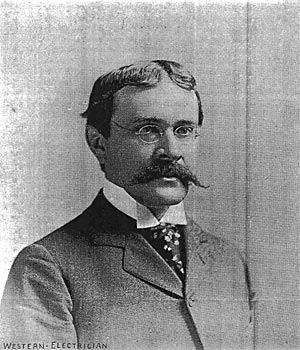[Trade Journal]
Publication: Western Electrician
Chicago, IL, United States
vol. 16, no. 21, p. 251-252, col. 2-3,1-3
New Officers of the Institute.
The annual meeting of the American Institute of Electrical Engineers was held on the evening of the 21st instant, and officers were elected as follows:
President — Louis Duncan, Baltimore.
Vice-presidents — M. I. Pupin, New York; W. F. C. Hasson, San Francisco; Angus S. Hibbard, Chicago.
Managers — Carl Hering, Philadelphia; B. J. Arnold, Chicago; Chas. F. Scott, Pittsburg; Cary T. Hutchinson, New York.
Treasurer — Geo. A. Hamilton, New York.
This is an admirable ticket, representative of the various branches of the industry, well distributed geographically and made up mainly of young and progressive men. The WESTERN ELECTRICIAN herewith presents portraits and brief biographical sketches of the new officers.
LOUIS DUNCAN, Ph. D., the new president, although one of the youngest men ever elected to the position he holds, is widely known to the electrical engineering profession. He was born in 1862, educated in the United States Naval Academy and at the Johns Hopkins University. Mr. Duncan graduated at Annapolis in 1880, after which he went for a two years' cruise, the greater part of the time being spent at the South Pacific and China stations. In 1882 he was ordered to the Johns Hopkins University, Baltimore, on special duty. Two years later he was stationed in Philadelphia at the International Electrical Exhibition held by the Franklin Institute. He was there made chairman of the committee which made competitive tests of dynamo-electric machinery and electric lamps. In 1885 he was given the degree of Ph. D. by the Johns Hopkins University, and in the fall of that year was ordered to sea by the Navy Department. In 1887 he was requested to organize a department of applied electricity at the Johns Hopkins University, and resigned from the navy to accept the appointment of associate professor of electricity in that institution. Dr. Duncan is the author of a number of papers which have appeared in the different magazines during the last few years. He was elected an honorary life member of the Franklin Institute, is past vice-president of the American Institute of Electrical Engineers, and a member of the Mathematical Society of France. In addition to his work at the Johns Hopkins University, Dr. Duncan has done a considerable amount of work in electrical engineering. Among other things, he, with Frank J. Sprague and Dr. Cary T. Hutchinson, designed and built a 1,000 horse power electric locomotive for the North American company. He is acting as electrical engineer for the Baltimore & Ohio Railroad company in the installation of a plant designed to draw the trains of that system through a tunnel running the entire length of the city of Baltimore. He has also acted as engineer for the Baltimore Traction Syndicate and a number of other large electric railway corporations.
| |||
| New Officers of the Institute. — Louis Duncan, President. |
MICHAEL I. PUPIN, Ph. D., professor of mechanics in Columbia College, New York, is one of the foremost authorities in the country in the investigation and demonstration of the pure science of electrical phenomena applied to mechanics. He was born in 1858 on the military frontier of Austria, but came to the United States at the age of fourteen. In 1879 he entered Columbia College, graduating in 1883 with honors in the classics and in mathematics. He continued his studies in physics and mathematics under von Helmholtz at the University of Berlin, and in 1889 he obtained the degree of Ph. D., with high honors, from that seat of learning on a dissertation in thermodynamics entitled "Osmotic Pressure and Its Relation to Free Energy." This dissertation forms a continuation of von Helmholtz' investigations of the thermodynamics of chemical processes. Dr. Pupin was appointed instructor in mathematical physics at Columbia College in 1889, and three years later he was made professor of mechanics in the same institution — a position he still holds. Dr. Pupin has been a member of the Institute since 1890 and was elected a manager in 1892. He is vice-president, also, of the New York Electrical society, and has taken out several patents for inventions in long-distance telephony and multiplex telegraphy. He has contributed freely to scientific and technical periodicals, and his articles always secure respectful attention.
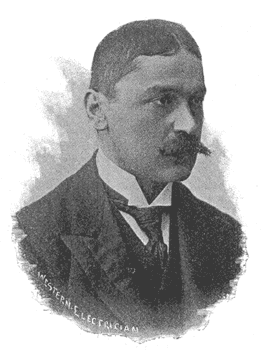 |
| New Officers of the Institute. — M. I. Pupin, Vice-President. |
W. F. C. HASSON, like Dr. Duncan and several other eminent American electricians, is an ex-naval officer. He was born in Cincinnati in 1857, and graduated from the Woodward High School in 1876. In the same year he entered the United States Naval Academy at Annapolis as a cadet engineer. During the course at the Naval Academy Mr. Hasson enjoyed the distinction of being a "star" member of his class, the name being derived from a gold-embroidered star worn on the collar of uniforms, this honor being conferred by the academy authorities for brilliant class standing. He graduated in the engineering force in 1880. In 1882 he was commissioned assistant engineer of the United States Navy. He resigned from the navy February 1, 1893, to enter into private practice in San Francisco, and since that time has been a consulting electrical engineer. He is a director of the Technical Society of the Pacific Coast and a member of the American Institute of Mining Engineers, of the American Society of Naval Engineers, and was a late associate in applied mechanics in the Johns Hopkins University. His prominent position in electrical circles on the Pacific coast caused Lieut. Hasson to be selected as chief of the electrical department of the California Midwinter Exposition, held in San Francisco last year. Lieut. Hasson has also been connected with several important power transmission projects on the coast.
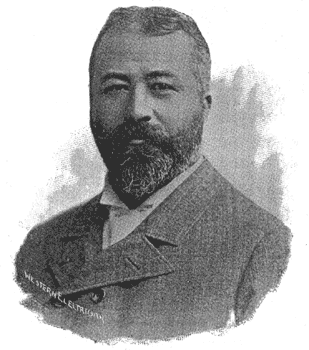 |
| New Officers of the Institute. — W. F. C. Hasson, Vice-President. |
ANGUS S. HIBBARD is one of the leading telephone men of the country. At the head of a company possessing an exchange doing a larger business than any other in the United States, he is a recognized authority on all questions pertaining to this branch of the electrical industry. Mr. Hibbard was born in Milwaukee on February 7, 1860, and was educated in the Milwaukee Academy and Racine College. In 1878 he was chief clerk to the general superintendent of the Northwestern Telegraph company, who, as agent of the Bell Telephone company, began the introduction of telephones in Wisconsin. In this connection young Hibbard went into telephone work exclusively in 1881 as superintendent for Wisconsin, and built 54 exchanges and 2,800 miles of toll line in that state. In 1886 Mr. Hibbard went to New York as general superintendent of the American Telephone & Telegraph company and opened the New York and Philadelphia lines of that company for the first long-distance business. He continued in charge of that company's lines in its extensions throughout the eastern and central states, and opened the New York-Chicago line for business in October, 1892. He came to Chicago February 1, 1893, as general manager of the Chicago Telephone company, since which time that company's exchange has advanced to first place in the country, having 11,000 subscribers, and its traffic has grown to the handling of over 250,000 messages per day.
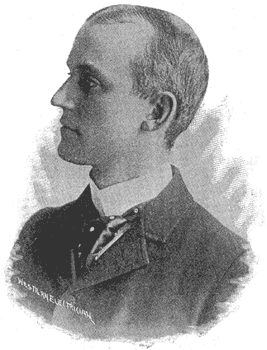 |
| New Officers of the Institute. — Angus S. Hibbard, Vice-President. |
CARL HERING, B. S., M. E., is a native of Philadelphia, his present home. He was born in 1860, his father being the late Dr. Constantine Hering, founder of homeopathy in America. In 1880 he graduated from the University of Pennsylvania with the degrees of bachelor of science and mechanical engineer. From 1881 to 1883 he was connected with his alma mater as instructor and assistant professor. Mr. Hering has been particularly active in work connected with electrical expositions and international deliberations connected therewith. In 1883, at the age of 23, Mr. Hering was elected commissioner of the Franklin Institute of Pennsylvania to the International Electrical Exhibition at Vienna, where he was an active member of the international jury which undertook the scientific tests of the exhibits. He then continued his studies at the Polytechnikum in Darmstadt, Germany, under Prof. Kittler, which was at that time one of the very few colleges where electrical engineering was taught as a special course, and shortly after beginning his studies Prof. Kittler appointed him his assistant. In 1884 he became active electrician for the Philadelphia International Electrical Exhibition and member of the scientific commission appointed to make the tests and reports. In the latter capacity he urged the importance of a comparative life-test of incandescent lamps, which, though at first opposed and ridiculed by many members of the commission, was finally started and was afterward carried out by Prof. Marks for the Franklin Institute. In 1885 he was electrical engineer for one of the large manufacturers in Germany, and afterward for a company in Philadelphia, after which he commenced practicing as consulting electrical engineer in the latter city. In 1889 Mr. Hering was sent to Paris by the United States government to make the report on the electrical exhibits at the Paris International exposition and was appointed a member of the jury in class 62 (electricity). He was also elected delegate from the Franklin Institute to this exhibition for the class electricity, and was representative of the American Institute of Electrical Engineers at the International Electrical Congress in Paris. At the close of the exhibition he received the decoration known as the "Gold Palms" from the French government. In 1891 he was chairman of the delegation of the American Institute of Electrical Engineers at the Electrical Congress held in Frankfurt, Germany, at the time of the electrical exhibition in that city, in which capacity he urged the adoption of the "henry" and the magnetic units proposed by the Institute. He took an active part in the deliberation of that congress, and was elected vice-president of one of the sections. He was active in urging and preparing the proposed preliminary programme for the Chicago Electrical Congress of 1893, as published by the American Institute of Electrical Engineers. Mr. Hering has long been a prominent member of the Institute and is the author of a number of papers on electrical subjects and of two books on dynamos. He is the inventor of several improvements in dynamos and storage batteries.
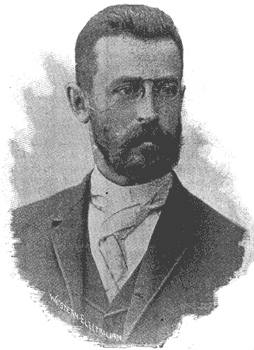 |
| New Officers of the Institute. — Carl Hering, Manager. |
B. J. ARNOLD, with Mr. Hibbard, represents Chicago in the list of Institute officers. He is a consulting electrical engineer, who has devoted particular attention to railway practice. Mr. Arnold has had much to do with the local branch of the Institute, giving his time as honorary secretary, and his personal popularity is largely responsible for the success of the meetings. Mr. Arnold was born in 1861 at Grand Rapids, Mich. Removing to Nebraska, he entered the University of Nebraska, in 1879, taking the civil engineering course for one year. Then he returned to Michigan, entering Hillsdale College, from which he graduated with the degree B. S. in 1884, taking a mathematical prize for a six years' course. Later the same institution conferred on him the degrees of M. S. and M. Ph. for subsequent work. Mr. Arnold also took a post-graduate course in electrical engineering at Cornell University. Mr. Arnold has a pronounced aptitude for mechanics and for practical electrical application. He has led a busy life, and his work as a railway engineer has attracted wide attention, particularly the station at Little Rock, Ark., and the great intramural plant at the World's Fair. He is a member of several engineering societies and has made valuable contributions to technical literature.
CHAS. F. SCOTT was born at Athens, Ohio,, in 1864. He attended the Ohio University at Athens, and then entered the Ohio State University, Columbus, where he graduated in 1885. He then took a course of graduate work at the Johns Hopkins University, and in the summer of 1887 entered the electrical field with a construction company in Philadelphia. In August, 1888, he entered the employment of the Westinghouse company in Pittsburg, beginning work in the dynamo room on night duty. He was soon transferred to the laboratory, and was assistant to Mr. Tesla during the latter part of that inventor's work on alternating current motors at Pittsburg. After the departure of Mr. Tesla, Mr. Scott was placed in charge of the experimental work on the Tesla motor, which he continued for about a year. He was then appointed assistant electrician. Subsequently he was made chief electrician, when Mr. Shallenberger gave up the position for that of consulting electrician to the company, Mr. Scott continues as electrician of the Westinghouse Electric & Manufacturing company, and is closely identified with the electrical work of that company in its new factory at East Pittsburg.
CARY T. HUTCHINSON, Ph. D., was graduated in 1886 by the Washington Universily at St. Louis with the degree of Ph. D. From 1886 to 1889 he studied at Johns Hopkins University, under Prof. Rowland and Dr. Duncan, following the courses in physics and electrical engineering; he was appointed fellow in physics, and received, in 1889, the degree of Ph. D. and the certificate of the electrical engineering course. He was with the Sprague Electric Railway & Motor company and the Edison General Electric company for about two years. In January, 1892, the firm of Sprague, Duncan & Hutchinson, of which he was a member, began business. Since the dissolution of this firm in May, 1894, he has been practicing as consulting electrical engineer, with offices in New York. He is a member of the American Institute of Mining Engineers and the American Society of Mechanical Engineers, as well as of the Electrical Engineers. Under Dr. Duncan, he and Mr. Wilkes made the first experimental determination of the form of alternate current curves by the instantaneous contact method which has come into such extensive use. He has written various articles for the technical journals.
GEORGE A. HAMILTON, the new treasurer, who succeeds the late George M. Phelps, was for years identified with the telegraph business of the country. Born in Cleveland, O., in 1843, Mr. Hamilton began service as a messenger in 1860, and for the next thirteen years worked up as operator and manager in Salem and Ravenna, O., and Pittsburg and Meadville, Pa. In 1873 he became assistant to Prof. Farmer at Boston, and he served in this capacity for two years. From 1875 to 1889 he was first assistant electrician and then electrician to the Western Union Telegraph company in New York. For the last six years Mr. Hamilton has been the electrician of the Western Electric company in New York. He is widely acquainted in electrical circles.
The secretary of the Institute, Ralph W. Pope, has filled the position he holds most acceptably for ten years. His is not an elective office, and he will undoubtedly be re-appointed by the council. A portrait and sketch of Mr. Pope were published in the WESTERN ELECTRICIAN of June 11, 1892.

